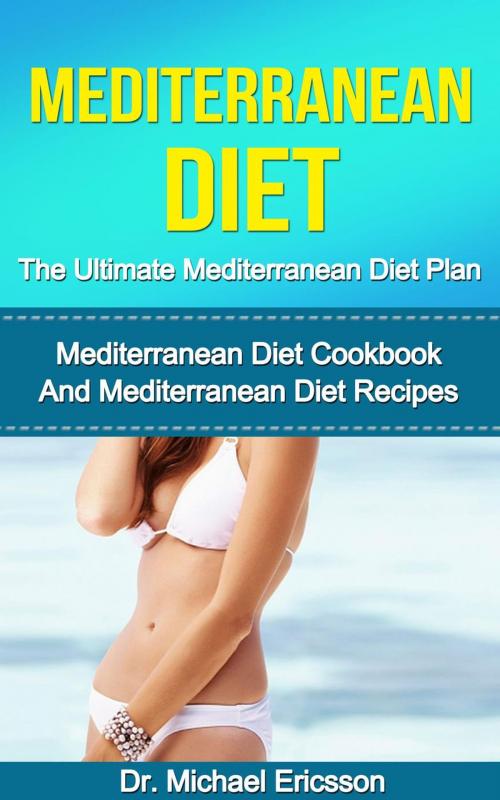Mediterranean Diet: The Ultimate Mediterranean Diet Plan: Mediterranean Diet Cookbook And Mediterranean Diet Recipes
Nonfiction, Health & Well Being, Health, Nutrition & Diet, Food Content Guides, Weight Loss, Diets| Author: | Dr. Michael Ericsson | ISBN: | 9781507072073 |
| Publisher: | Dr. Michael Ericsson | Publication: | January 9, 2015 |
| Imprint: | Language: | English |
| Author: | Dr. Michael Ericsson |
| ISBN: | 9781507072073 |
| Publisher: | Dr. Michael Ericsson |
| Publication: | January 9, 2015 |
| Imprint: | |
| Language: | English |
Mediterranean Diet: The Ultimate Mediterranean Diet Plan and Read on your PC, Mac, smart phone, tablet
This book contains the basics of the popular Mediterranean Diet and more than 30 recipes of delicious healthy snacks and dishes that you can enjoy during your Mediterranean diet experience.
The Mediterranean diet is a result of what is considered a paradox by the mainstream nutritional point of view. It has been observed that although people living in the Mediterranean region consume similar levels of fat as those of people living in countries like the United States, they have significantly lower rates of cardiovascular disease. A study of their cuisine and staples resulted in this rich yet effectively healthful Mediterranean diet that is now one of the most popular nutritional recommendations in modern medicine.
The recipes included in this cookbook contain the Mediterranean diet requirements and yet prove to be enjoyable, delicious food for you and your family.
Here Is A Preview Of What You'll Learn
The Basics of Mediterranean Diet
Dishes
Fresh Fruit Desserts
Salads
Smoothies
Other Recipes
Much, much more!
The Basics of Mediterranean Diet
This chapter will serve as a basic crash course into the popular dietary recommendation of the 1990s called the Mediterranean Diet as a form of introduction to the recipes to be discussed in this cookbook.
This modern nutritional recommendation was originally inspired by the dietary patterns prevalent in Spain, South Italy, and Greece. The aspect principal to this diet is the high consumption of legumes, olive oil, vegetables, fruits, and unrefined cereals. It also includes moderate to high proportional consumption of fish, moderate consumption of wine and dairy products like cheese and yogurt, and low meat consumption.
Despite its name, not all Mediterranean countries’ cuisine is typical for this diet. For example, the high lard and butter content of North Italian cuisine, where olive oil use is restricted to garnishing salads, is not in accordance to the principles of the Mediterranean diet as recommended by health experts. Because of the differences in the food and eating habits of the neighboring countries on the opposite sides of the Mediterranean Sea, it can be said that there is no single Mediterranean Diet that is to be considered the ideal.
However, the most common version of the diet was that presented by the Harvard University’s School of Public Health. They mention that the diet is basically the food patterns found to be typical in Crete and in pretty much the rest of Greece and South Italy during the early 1960s.
Mediterranean Diet: The Ultimate Mediterranean Diet Plan and Read on your PC, Mac, smart phone, tablet
This book contains the basics of the popular Mediterranean Diet and more than 30 recipes of delicious healthy snacks and dishes that you can enjoy during your Mediterranean diet experience.
The Mediterranean diet is a result of what is considered a paradox by the mainstream nutritional point of view. It has been observed that although people living in the Mediterranean region consume similar levels of fat as those of people living in countries like the United States, they have significantly lower rates of cardiovascular disease. A study of their cuisine and staples resulted in this rich yet effectively healthful Mediterranean diet that is now one of the most popular nutritional recommendations in modern medicine.
The recipes included in this cookbook contain the Mediterranean diet requirements and yet prove to be enjoyable, delicious food for you and your family.
Here Is A Preview Of What You'll Learn
The Basics of Mediterranean Diet
Dishes
Fresh Fruit Desserts
Salads
Smoothies
Other Recipes
Much, much more!
The Basics of Mediterranean Diet
This chapter will serve as a basic crash course into the popular dietary recommendation of the 1990s called the Mediterranean Diet as a form of introduction to the recipes to be discussed in this cookbook.
This modern nutritional recommendation was originally inspired by the dietary patterns prevalent in Spain, South Italy, and Greece. The aspect principal to this diet is the high consumption of legumes, olive oil, vegetables, fruits, and unrefined cereals. It also includes moderate to high proportional consumption of fish, moderate consumption of wine and dairy products like cheese and yogurt, and low meat consumption.
Despite its name, not all Mediterranean countries’ cuisine is typical for this diet. For example, the high lard and butter content of North Italian cuisine, where olive oil use is restricted to garnishing salads, is not in accordance to the principles of the Mediterranean diet as recommended by health experts. Because of the differences in the food and eating habits of the neighboring countries on the opposite sides of the Mediterranean Sea, it can be said that there is no single Mediterranean Diet that is to be considered the ideal.
However, the most common version of the diet was that presented by the Harvard University’s School of Public Health. They mention that the diet is basically the food patterns found to be typical in Crete and in pretty much the rest of Greece and South Italy during the early 1960s.















